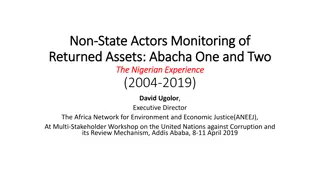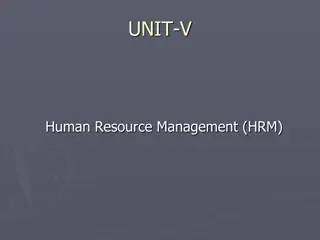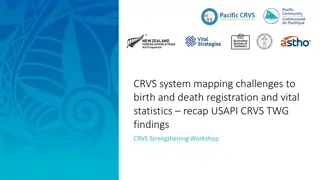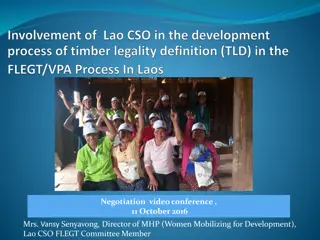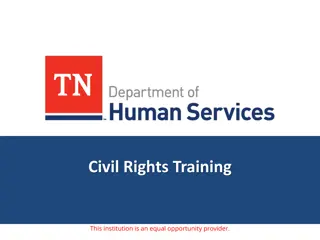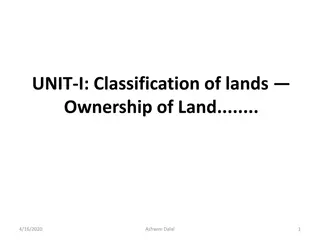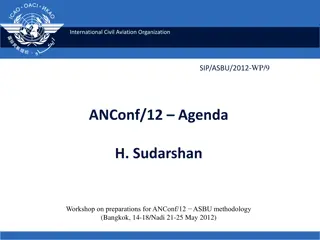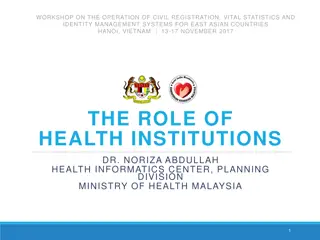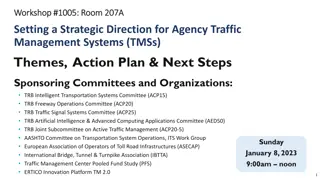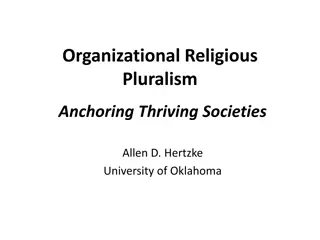Strengthening Human Resource Management of Civil Society Organizations Workshop by Jagath Karunathilaka
This workshop conducted via virtual meeting using Zoom technology aims to enhance the human resource management practices of civil society organizations. It covers various topics such as business code practices, recruitment, rewards & recognition, conflict management, employee rights, and more. Participants will gain insights into employment laws, employee rights, and ways to seek relief through labor tribunals and human rights commissions in the Sri Lankan context.
Download Presentation

Please find below an Image/Link to download the presentation.
The content on the website is provided AS IS for your information and personal use only. It may not be sold, licensed, or shared on other websites without obtaining consent from the author. Download presentation by click this link. If you encounter any issues during the download, it is possible that the publisher has removed the file from their server.
E N D
Presentation Transcript
Workshop on Workshop on Strengthening Human Resource Strengthening Human Resource Management of Civil Society Management of Civil Society Organizations Organizations By By Jagath Jagath Karunathilaka Karunathilaka (Through Virtual Meeting (Through Virtual Meeting Zoom Technology) October 4 October 4 22 22 (20 Lesson Hours in 10 Days) (20 Lesson Hours in 10 Days) Zoom Technology)
Lesson Plans of HR Management of CSO Lesson Plans of HR Management of CSO Chapter No Lesson Topics Scheduled Date Timing Monday, 4th October 1 Business Code Practice, Compliance and Data Security Employment Practices 10.00 12.00am 2 Tuesday, 5th October 3 Recruitment, Selection and Induction 10.00 11.30am Wednesday, 6th October 4 General Terms and Conditions of Employment 10.00 12.00am Thursday, 7th October 5 Rewards and Recognition 10.00 11.30am Monday, 11th October 6 Performance Review, Training & Learning Practices Superannuation and Severance 9.00 12.00am Tuesday, 12th October 7 10.00 11.30am Wednesday, 13th October Thursday, 14th October 8 Conflict and Grievance Management 10.00 11.30am 9 Disciplinary Management 9.00 12.00am Thursday, 21st October 10 Employment Law & Employee Rights 10.00 12.00am Friday, 22nd October 11 Current Issues & Trends in HRM 10.00 11.30am
Chapter 10: The Employee Law and Chapter 10: The Employee Law and Employee Rights Employee Rights About About This Chapter This Chapter The Employee Law and Employee Rights chapter is about Equal Employment Opportunity (EEO) regulations and the laws relating to Human Resource Management (HRM) in an organizations. The guidance and the tools introduced through this chapter can help you to set up, revise or realign existing employment practices complied with related regulations and laws.
The The Employee Law and Employee Law and Employee Employee Rights Rights Topic Topic Content Covered Content Covered Employment Laws: Legal Framework in Sri Lankan Context of Labor Laws Overview of labor laws and regulations connected to HRM: Law relating to the employment and termination from employment Please see Annex I: legal framework in Sri Lankan context of labor laws Employee Rights: How Employee Seek Relief from Labor Tribunal (LT), Human Right Commission (HRC) and Government Ombudsmen Provision available under the Industrial Disputes Act for employees to seek relief from Labour Tribunals in relation to Termination of Employment and the possible relief garneted by LT including reinstatement of workmen subject to an appeal firstly to the High Courts and thereafter even to the Supreme
The The Employee Law and Employee Law and Employee Rights Employee Rights Topic Topic Content Covered Content Covered Health and Safety Regulations Occupational Health and Safety Administration (OSHA) regulations, including their relationship to HRM Occupational safety & health conditions mandatory provisions is available under the Shop and Office Employees Act Equal Employment Opportunity Regulations and Fair Labor Standards Explanations of the various type of discriminations faced by female employees due to their gender gap and fair labor standards and the provisions available them to treat with equality
Overview of Sri Lankan legislation on Labour Legislation in Sri Lanka relating to Industrial, Employment and Labour relations can be divided into seven categories as follows; 1. Laws on Social Security i. Employees provident Fund Act ii. Employees Provident Fund (Special Provisions) Act iii. Employees Trust Fund Act iv. Employees Trust Fund (Special Provisions) Act v. Payment of Gratuity Act
Overview of Sri Lankan legislation on Labour 2. Laws on Welfare and Well-being of Employees i. Employment of Women, young Persons and Children Act ii. Maternity Benefits Ordinance iii. Employment of Females in Mines Act 3. Occupational safety and health and Workmen s compensation i. Factories Ordinance ii. Workmen s Compensation Ordinance
Overview of Sri Lankan legislation on Labour 4. Laws relating to terms and conditions of Employment i. Wages Board Ordinance ii. Shop and Office employees (Regulation of Employment and Remuneration) Act iii. Employment of Trainees (Private Sector) Act 5. Labour relations i. Trade Union Ordinance ii. Employees Councils Act iii. Industrial Disputes Act iv. Termination of Employment of Workers (Special Provisions) Act
Overview of Sri Lankan legislation on Labour 6. Law relating to Plantations and Estate labour i. Estate Labour (Indian) Ordinance ii. Medical Wants Ordinance iii. Indian Immigrant Labour Ordinance iv. Minimum Wages (Indian Labour) Ordinance v. Trade Union Representatives (Entry in Estates) Act vi. Estate Quarters (Special Provisions) Act vii. Allowances to Plantation Workers Act viii. Services Contracts Ordinance 7. Foreign Employment i. Sri Lanka Bureau of Foreign Employment Act
Laws relating to Social Security Social Security of employees are addressed by three main mechanisms. They are the Employees Provident Fund, Employees Trust Fund and the Gratuity Fund. By them employees are granted financial benefits upon completion of a statutory period of service, change of employment or reaching the retirement age.
Laws relating to Social Security Employees Provident Fund (EPF) The Employees Provident Fund Act 15 of 1958 applies to all workers and lays down rules for contribution by employers and workers and other administrative rules. EPF was first established in 1958, since then there have been nine Amending Acts on the subject. Employers have to remit every month to the Central Bank, an amount equivalent to 20% of the employee s total earnings to the Fund. The Employee s contribution is 8% and the Employer has to contribute an amount equivalent to 12% of the employee s total earnings.
Laws relating to Social Security Employees Provident Fund (EPF) Earnings include wages, cost of living allowances and similar allowances, payment in respect of holidays and leave, cash value of food provided by the employer and meal allowance but excludes overtime payments. Payments for work done during normal working hours on weekly holidays, Poya days or public holidays should also be considered as earnings for the computation of EPF contributions. Failure to remit EPF results in surcharges ranging from 5% to 50%.
Laws relating to Social Security Employees Trust Fund (ETF) The Employees Trust Fund Act No. 46 of 1980 (as amended) obliges the employer only to contribute monthly 3% of the employee s total wages to the Trust Fund created under it. ETF Act of 1980, unlike the Employees Provident Fund, has contributions only from the employer
Laws relating to Social Security Gratuity The Payment of Gratuity Act 12 of 1983 provides for the payment of gratuity to workers who have at least five years of service irrespective of whether they are dismissed, leave or die in service, subject to the rules that if they are dismissed for fraud or causing loss, the payment could be reduced by the extent of the loss. Gratuity to an employee Is over and above the EPF and ETF payments discussed above and is governed by the Payment of Gratuity Act No. 12 of 1983.
Laws relating to Social Security Gratuity A gratuity is a lump sum payment made in recognition for services at the end of a period of employment. Under the Act any employer who has employed more than 15 workmen in any industry during the twelve months preceding the termination of the workman in question, is required to pay a gratuity to that workman if he has completed five years of service under him The amount for monthly paid employee is calculated at the rate of half a month s salary for each completed year of service. Gratuity is also payable to workmen who are paid weekly or daily, at the rate of 14 days salary for each completed year of service.
Laws relating to Social Security Gratuity Gratuity is payable whether termination was by the employer of employee, except if the termination was for reasons of fraud, misappropriation of the employer s money or willful damage to the employer s property, the amount of the loss or damage may be deducted from the amount of gratuity due under the Act. If the workman dies while employed, any gratuity due to him must be paid to his legal heirs.
Laws relating to Welfare/Well-being of the Employees Employment of Females in Mines Ordinance No female of any age at any time, who have not been exempted by regulation, shall perform or be employed on any underground work in a mine or enter a mine for the performance of any work.
Laws relating to Welfare/Well-being of the Employees Maternity Benefits Ordinance The Maternity Benefits Ordinance 32 of 1939 covers all female workers other than those who are specifically provided for under the Shops & Offices Act provides leave with fully paid for children and feeding intervals. Subsequently, there were seven other amending Acts passed in this regard from 1952 to 1985. An employee is restricted from knowingly employing any women during the period of four weeks immediately following her confinement. Maternity benefits mean the amount payable under the provisions of this Ordinance to a woman worker.
Laws relating to Welfare/Well-being of the Employees Maternity Benefits Ordinance A woman worker who has no children or has only one child is entitled to a period of twelve weeks for which maternity benefits must be paid by the employer. However, in the event the woman has two or more children, she will be entitled for a 6 weeks period of maternity benefits.
Laws relating to Welfare/Well-being of the Employees Employment of Women, Young Persons and Children Act The Employment of Women, Young Persons & Children s Act 47 of 1956 regulates the employment of children, youth and women especially in relation to hours of work. There are three Acts on this subject. They are in relation to employment of Women, Young Persons and Children at, Night Industrial Undertakings and at sea Other than Industrial Undertakings and at sea.
Laws relating to Welfare/Well-being of the Employees Employment of Women and Young Persons at Night The legislation prohibits employment of any person under the age of 18 years at night whether in a public or private industrial undertaking or branch. Women can be employed at night subject to certain basic requirements. It must be voluntary and written authority must be got from the Labour authorities for working after 10.00 p.m.; for night work she must get 1.5 times the normal pay; female wardens must ensure the worker s welfare; there must be availability of rest rooms and refreshments and not more than ten days of night work can be allocated per month
Laws relating to Welfare/Well-being of the Employees Employment of Women and Young Persons at Night Exemptions are granted to women holding a management or technical nature position, or those who are employed in health and welfare services and in an industrial undertaking in which only members of the family are employed.
Laws relating to Welfare/Well-being of the Employees Employment in Industrial Undertakings and at Sea No employer can employ a child of age 15 or below unless otherwise the undertaking or the ship is one which only members of the same family are employed or children from a technical school with the approval and under the supervision by an authority of the technical school
Laws relating to Welfare/Well-being of the Employees Employment other than Employment in Industrial Undertakings and at Sea This part of the Ct applies in relation to employment other than employment in industrial undertakings and at sea. Children under 14 cannot be employed during school hours and in the nights (8.00 p.m. to 6.00 a.m.) and must not be made to lift or move heavy items which can injure the child. Nor can such children be given work in any occupation injurious to their health, education or well-being as spelt out in the relevant provisions. Importantly, no such child can be employed in that are called street industry .
Occupational Safety and Health, Factories Ordinance and Workmen s Compensation The Factories Ordinance 45 of 1942 prescribes conditions and rules in relation to workers employed in work connected with goods being made, altered, repaired, or animals slaughtered in pursuance of a trade or for gain. Occupational health is regulated by the Factories Ordinance of 1942 and all persons operating factories are conversant with the comprehensive provisions of this legislation first enacted in 1942. There have been over seven amendments to the law. Three main areas covered are health, safety and welfare as follows;
Occupational Safety and Health, Factories Ordinance and Workmen s Compensation Health Every factory must be kept clean with a conducive work environment. It must not be overcrowded; there must be proper temperature, fresh air and ventilation. Floors must not be wet and there must be suitable and sufficient hygiene and sanitary convenience recognizing the different sexes.
Occupational Safety and Health, Factories Ordinance and Workmen s Compensation Safety Every possible area of safety appears to have been covered since these provisions are taken from well tested English legislation. For example, proper fencing of machinery, protection against dangerous substances, stairways, gangways to the property to be fenced, proper training before an employee is asked to work on machines and preventive measures in handling items like hoists, lifts, cranes, boilers and explosives etc. Provisions are also made against accidents by fire.
Occupational Safety and Health, Factories Ordinance and Workmen s Compensation Welfare Some of the key areas covered in this part of the statute is the supply of safe drinking water, clothing for factory work, washing facilities, proper restrooms and seating facilities etc.
Occupational Safety and Health, Factories Ordinance and Workmen s Compensation Workmen s Compensation The Workmen s Compensation Ordinance, first enacted in 1934, provides for the payment of compensation to workmen who are injured in the course of their employment. Since its enactment it has been amended several times especially by Act No. 15 of 1990. The Ordinance specifies and regulates the employer s liability to pay compensation and specifies the instances in which the compensation should be paid. The compensation has to be paid for a) An injury to a workman by accident arising out of and in the course of his employment b) An occupational disease contracted by an employee whose service is not less than six months in any process which is directly attributable to the nature of his employment.
Occupational Safety and Health, Factories Ordinance and Workmen s Compensation Workmen s Compensation The amount if compensation is to be determined by the Commissioner of Labour or his Authorised Officers depending on the nature of injury to the workman. Most employees take out insurance policies with insurers to cover this risk. An issue that normally arises is whether the accident to the workman arose in the course of his employment . An accident that occurred when the workman was at his own home or at a time after or before work will not be covered. Also, the workman will not be covered for accidents caused when he was under the influence of liquor or drugs or was guilty of willful disregard of the safety equipment and procedures provided at the workplace. A claim for workmen s compensation must also be made within two years of the accident.
Occupational Safety and Health, Factories Ordinance and Workmen s Compensation Workmen s Compensation If an employer fails to pay, the workman or his dependant can apply to the Commissioner of Labour within one year of the accident. An employer who fails to pay within thirty days is liable to a surcharge, while wrongful refusal to pay can also result in a fine. A claim under the Workman s Compensation Ordinance does not prejudice the right of a workman or his dependents to institute proceedings in a District Court of the area where the accident occurred for the recovery of damages. However, in such a case he will be bound by the general principles of delictual liability that usually require proof of negligence unless the employer was in breach of some duty imposed on him by statute. Any award for damages by the court will normally take into account any sum already paid to the workman under legislation.
Laws relating to terms and conditions of Employment Wages Boards The Wages Boards Ordinance 27 of 1941 prescribes legal obligations with regard to salaries and wages of all employees and regulate the terms and conditions of employment of employees covered by the relevant boards as being part of the trade (44 wages boards are functioning under different trade) Wages Boards are bodies set up under the Wages boards Ordinance of 1941 (as amended) to ensure minimum wages and a few other conditions such as holidays, leave and overtime rates in respect of specified trades.
Laws relating to terms and conditions of Employment Wages Boards These Wages boards comprise an equal number of representatives of employers and employees in a given trade and up to three persons appointed by the Minister of Labour. Their principal function is to determine the minimum wage payable to Workers in a particular trade. Many employees pay more than the minimum wage. The minimum wage may be prescribed as a basic rate plus a special living allowance based on the cost of living index or a consolidated amount. Failure to pay at least the minimum wage is an offence. Employees can, however, receive a higher wage by agreement with the employer. They often do.
Laws relating to terms and conditions of Employment Shop and Office employees (Regulation of Employment and Remuneration) Act The Shop & Office Employees Act 19 of 1954 covers the terms and conditions applicable to the workers covered by it. It covers conditions of employment and remuneration. It also provides for maternity benefits in relation to females in shops and offices. Occupational safety & health conditions mandatory provisions is also available. The Act applies to all employees within the definition of a shop or office and is in five parts as follows; o Part I : Regulation of hours of employment in shops and offices: health and comfort of employees o Part II : Payment of remuneration o Part III : Regulation of remuneration o Part IV : Closing order for shops o Part V : General matters
Laws relating to terms and conditions of Employment Shop and Office employees (Regulation of Employment and Remuneration) Act The Act does not apply to the State as an employer. Unlike, the Wages Boards Ordinance, this Act specifically defines the entitlements of workmen, and does not vest decision making power in a separate autonomous body except under certain circumstances which is limited to wage fixation. The following main provisions of the Act are highlighted.
Laws relating to terms and conditions of Employment Shop and Office employees (Regulation of Employment and Remuneration) Act The Act does not apply to the State as an employer. Unlike, the Wages Boards Ordinance, this Act specifically defines the entitlements of workmen, and does not vest decision making power in a separate autonomous body except under certain circumstances which is limited to wage fixation. The following main provisions of the Act are highlighted
Laws relating to terms and conditions of Employment Shop and Office employees (Regulation of Employment and Remuneration) Act Hours of Work The normal day s work is limited to 8 hours and a normal working week is limited to 45 hours, excluding 1 hour for meals. Persons employed in different classes of shops and different classes of offices may have different hours of work, subject however, to several restrictions. Work in excess of the normal hours has to be treated as overtime and paid for at a rate not less than one and one-half times the hourly rate, calculated by dividing the monthly rate by 240. Executives in State Corporations are not entitled to overtime. The maximum amount of overtime is limited to 12 hours per week.
Laws relating to terms and conditions of Employment Shop and Office employees (Regulation of Employment and Remuneration) Act Weekly Holidays On completion of 28 hours of work in a week , the law provides for the granting of one and half days holidays with pay, Week is defined to mean the period between midnight on any Saturday night and midnight on the succeeding Saturday night.
Laws relating to terms and conditions of Employment Shop and Office employees (Regulation of Employment and Remuneration) Act Annual Holidays The total annual leave entitlement is 14, and provision is made when employment commences between certain specified periods for the granting of the corresponding number of days as leave, in the succeeding year. Public holidays are granted with remuneration. Full moon poya days should be observed as holidays. Employment on such days is strictly on an overtime basis.
Laws relating to terms and conditions of Employment Shop and Office employees (Regulation of Employment and Remuneration) Act Casual Leave The entitlement of casual leave for a calendar year is 7 days. This is to be utilized on account of private business or ill-health. In the commencing year of employment, one days is granted for every two completed months.
Laws relating to terms and conditions of Employment Shop and Office employees (Regulation of Employment and Remuneration) Act Maternity Leave Female employees are entitled to maternity leave as provided in the statute. These entitlements are now well known. Maternity leave shall be in addition to other leave or holiday entitlements. Salary payments and Deductions The Act placed time limited within which employees salaries should be paid and the deductions that may be made from such payments. Employers must strictly observe these conditions.
Laws relating to terms and conditions of Employment Shop and Office employees (Regulation of Employment and Remuneration) Act Letter of Appointment It is a fundamental requirement under this act that an employer issues a letter of appointment to the employee detailing the conditions of employment. This ensures to the employee certain inalienable rights under the law. The letter of appointment so issued becomes a contract between the parties.
Laws relating to terms and conditions of Employment Shop and Office employees (Regulation of Employment and Remuneration) Act Letter of Appointment The minimum requirements of a letter of appointment are spelt out in the Act. However, most employers have developed terms and conditions over and above what is required by the legislation. It is expected that if the letter of appointment is in English it be explained to the employee in his language (Sinhalese or Tamil) and he or she acknowledges that its terms and conditions were clearly understood. The employee is entitled to a copy of the letter of appointment.
Laws relating to terms and conditions of Employment Shop and Office employees (Regulation of Employment and Remuneration) Act Records of Employees Employers are obliged to maintain certain specified records in respect of their employees as provided by the legislation. This is normally done by maintaining a Register of staff and also a Personal file in respect of each employee which has a record of all details from date of joining etc.
Laws relating to terms and conditions of Employment Apprenticeship, Probation and Training General rules applicable This is an important area because may employees commence their career as apprentices, probationers and/or trainees. A contract of Apprenticeship is one where the employer agrees to instruct or teach the apprentice in his trade and to pay him an allowance during the existence of the relationship. The apprentice in turn agrees to serve the master and to learn from him.
Laws relating to terms and conditions of Employment Apprenticeship, Probation and Training General rules applicable The case of the Probationer is different and the assessment during the period of probation relates to his all round suitability, which includes both his ability to perform the job and his conduct. In the case of an apprentice, the emphasis is on the learning of a skill and it follows that a person engages in a period of apprenticeship only in respect of a job which requires a certain degree of skill, which has to be acquired to perform the job. A probationer would also require some training but it would not necessarily be for the purpose of making him skilled as such.
Laws relating to terms and conditions of Employment Apprenticeship, Probation and Training General rules applicable Under the common law of employer and employee, an apprentice or trainee does not have a contract of service and is therefore not an employee. Yet, many of our statutes such as the Industrial Disputes Act, the Employees Provident Fund Act, the Termination of Employment of workmen (Special Provisions) Act and the Gratuity Act defines a workman to include an apprentice or trainee. Employers must be conscious of this.
Laws relating to terms and conditions of Employment Apprenticeship, Probation and Training General rules applicable Probation is a period during which an employer assesses the conduct and suitability of an employee for continued employment and the employee similarly assesses the suitability of the conditions of service from his point of view. The period of probation is a contract of service can therefore be taken as a communication by the employer that in the event of the employee proving himself within the period of probation to the satisfaction of the employer that the probationer is a fit and proper person to perform the duties for which he has been engaged. The probationer would be entitled to be confirmed in employment at the end of the probation period and if not, his services can be terminated without notice.
Laws relating to terms and conditions of Employment Apprenticeship, Probation and Training General rules applicable It should be noted that a probationer is a permanent employee in the sense that he is on a monthly contract of employment and the period of probation is strictly relevant only to the question of termination in the event of the probationer being unsatisfactory. As regards Trainees, a statute that employers currently resort to is the Employment of Trainees (Private Sector) Act No. 8 of 1978. This legislation was enacted to boost training of unemployed persons. Those employing trainees under this Act are provided specified monetary incentives to pay such trainees but most employers pay more than what is statutorily provided.
Laws relating to terms and conditions of Employment Apprenticeship, Probation and Training General rules applicable Under it, without any prejudice to any scheme of training of, or to the employment of apprentices in any other law, an employer may enter into a contract of training with a person for a period not exceeding one year for the purpose of providing practical training to the trainee in any of the vocations specified in the Act and on the payment of a specified allowance. The vocations specified include:- a) Clerks, stenographers, book-keepers, typists, supervisors, salesmen, shop assistants, storekeepers, telephone operators, cashiers, foremen or any other similar vocations; b) Watchers, caretakers, bicycle orderlies, peons, liftmen, office and shop labourers, outside messengers, tea boys or other similar vocation.






